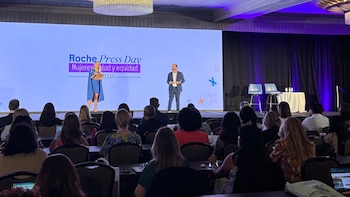


(Special envoy to Miami) Specialists from different Latin American countries met at the event called Roche Press Day 2024 where they presented studies focused on the health gaps that affect women. Late diagnosesfew leadership roles in research and cultural aspects are some of the indicators of inequality.
Stephanie Sassman of Genentech warned that women “take care of others and put their families before their own health”; In fact, when they go to the health system, women receive a delayed diagnosis of more than 700 types of diseases compared to men.
Within global problems, Sassman warned about the inequality that exists in the inclusion of women in clinical studies. “There is not enough data on how medications specifically affect women”, he remarked.
“We need to rethink health equity and to do so we need more experts, research and counseling panels, as well as more women in medicine and in health and medicine leadership, because we ask different questions, we communicate differently and we think differently. different research,” the professional noted.
For its part, Claudia Restrepoof Deloitte Health Equity Institutepresented a study on the hidden costs of not prioritizing women’s health. In Latin America it was shown that Women pay 18% more than men in annual out-of-pocket expensesin fact “women ages 19 to 64 on average pay more out of pocket than men of the same age, even when maternity claims are excluded.”
In turn, the study showed that for every dollar that a man receives as a salary, a woman obtains 0.82; For this reason, the wage gap leads to women having higher costs in medical care.
The professional also warned Roche Press Day that in Latin America the breast cancercervix and cervix require longer and more expensive treatment, added to the fact that there is no excess of latest generation treatments and this generates a longer treatment for women.

Faced with the demonstration of inequalities presented, the study suggested that to close the gaps it is necessary for insurers and employers to redesign benefit coverage to alleviate the financial burden for women and promote equity and well-being of both genders.
Valentina Sartoriof the McKinsey Health Institute and of World Economic Forumpresented the report called “Closing the gap in women’s health” and debunked some myths. In this regard, he stated that although women live longer than men, they experience a disease burden that is 25% greater than men. In fact, it was suggested that they have worse health in particular during their last years of life.
The health gap between men and women, if closed, could have a significant economic impact. According to recent estimates, Every dollar invested in closing this gap could translate into three dollars in economic growth..
This potential increase is due to greater labor participation, fewer lost hours and an increase in productivity, which could add at least $1 trillion to global GDP annually until 2040, Sartori explained. For the same date, it is estimated that, if the existing health gap is addressed, an impact equivalent to 137 million women accessing a full-time job could be achieved.
Like other professionals, Sartori agreed on the inequalities and problems that generate a late diagnosis for women. He polycystic ovary syndrome (PCOS)a condition unique to women, is often misdiagnosed due to lack of adequate testing. This disease, which affects a significant number of women, is often misinterpreted as simple weight gain related to lifestyle.
On the other hand, it was suggested that women face a significantly higher risk of receiving incorrect diagnoses in cases of heart attacks. According to the same report, women are 50% more likely to be misdiagnosed compared to men. While in autoimmune diseases, such as lupusalso present a particular challenge for women. The complexity of these diseases and the lack of sufficient studies have led to women facing higher mortality rates compared to men. So this situation results in a critical gap in medical care.
For this reason, specialists agreed on the urgent need to advance medical research focused on women. The lack of adequate testing and the tendency to minimize female symptoms as lifestyle problems contribute to a healthcare system that does not always respond to the specific needs of women.
